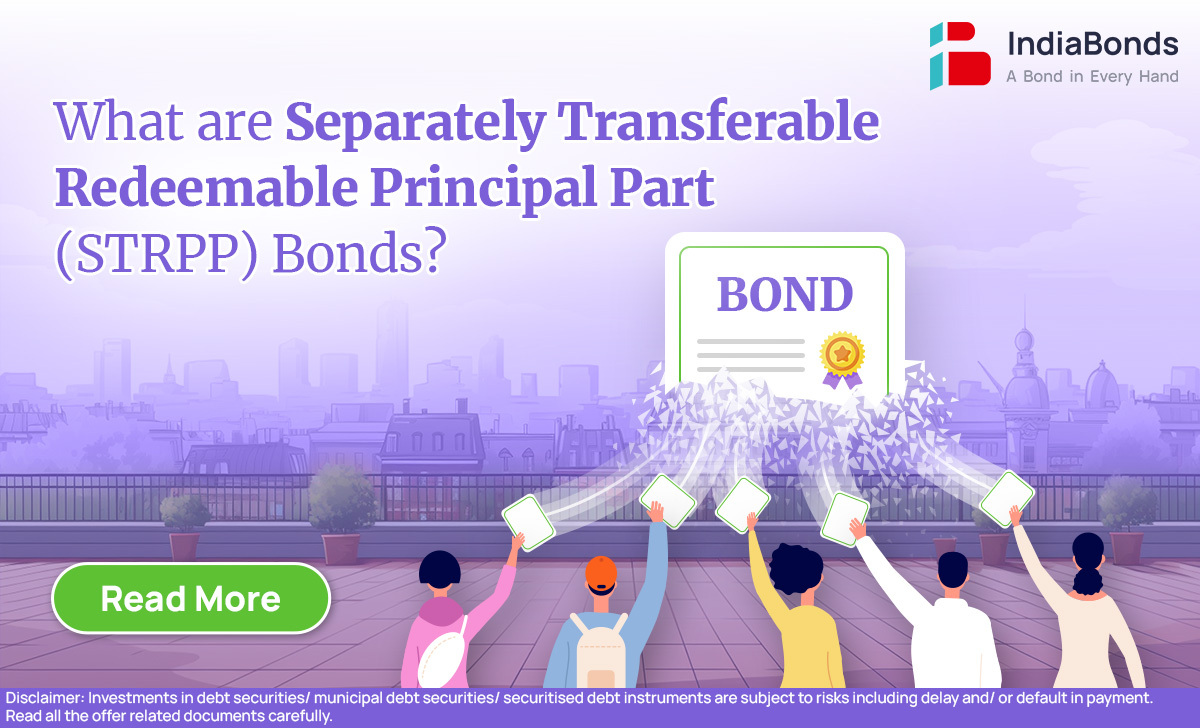
If you’ve ever skimmed through a bond’s term sheet, you may have encountered something like this: “Unsecured, Rated, Listed, Government Guaranteed, Redeemable, Taxable Non-Convertible Debentures in the nature of Bonds to be issued in the form of Separately Transferable Redeemable Principal Parts (STRPP)”. While this might seem like dense financial jargon, it’s essential to grasp the underlying concept to make better-informed investment decisions.
Of the plethora of terms and features in the bond universe—many of which are neatly explained in IndiaBonds’ BondUNi section—STRPP bonds stand out as an important concept. Adding this knowledge to your toolkit will help you become a more informed and capable investor. In this article, we’ll break down how STRPP bonds work, and also distinguish them from a similar term often confused with it—STRIPS.
At its core, a bond is a loan you give to an issuer (government or corporation), and in return, the issuer promises to pay interest (known as coupons) at regular intervals. At the end of the bond’s maturity, you receive the principal amount (the loan you originally gave). However, STRPP bonds add an interesting twist to this structure.
Instead of returning the principal in one lump sum at maturity (commonly referred to as a “bullet” payment), issuers of STRPP bonds can divide the principal into parts, which are paid back over a staggered schedule. Each of these principal parts can be traded separately in the market as an independent security. Let’s assume three different issuers with varying principal repayment schedules:
Issuer A decides to repay the principal in three phases—at the end of the 2nd, 4th, and 8th years—providing staggered payments.
Issuer B, on the other hand, prefers to make their redemptions towards the later part of the bond’s life, with payments starting from the 7th year and continuing annually until the 10th year.
Issuer C adopts a consistent approach, choosing to repay the principal over 10 years, with equal installments made at the end of each year, ensuring a steady redemption process for investors. This variation in repayment schedules allows issuers to manage their cash flow more effectively while providing investors with the flexibility to align their investments with their specific liquidity preferences. Additionally, issuers seek flexibility in repaying the principal over time but will continue to make coupon payments as agreed, ensuring consistent income for investors while offering more tailored repayment structures.
Imagine investing in a ₹100 bond with a 6% coupon, maturing in 2030. Instead of repaying the entire ₹100 at once in 2030, the issuer decides to repay ₹20 at the end of years 2026, 2027, 2028, 2029, and 2030. Each of these ₹20 repayments is treated as an independent tradable bond. Investors can buy and sell each principal payment in the market, allowing for more customized cash flow management.




In case of Separate Trading of Registered Interest and Principal of Securities (STRIPS), each individual cash flow component—whether it’s an interest payment or the principal repayment—can be traded independently. This differs from STRPP, where only the principal is paid out in staggered installments, and each repayment is treated as a tradable bond. For instance, if ₹100 of a 7% bond maturing in 2027 is stripped, each semi-annual coupon payment of ₹3.50 becomes a coupon STRIP, while the ₹100 principal repayment becomes a principal STRIP. These cash flows are then traded separately in the secondary market, allowing investors to buy or sell the coupon and principal payments independently based on their liquidity needs and investment preferences.
STRPP bonds are becoming increasingly popular in India’s debt market. A notable example is the International Finance Corporation (IFC) issuing its Maharaja Bonds, raising ₹6 billion (around $100 million). These bonds featured four tranches, including two STRPPs with staggered maturities ranging from 13 to 20 years. The proceeds were allocated for infrastructure investments in India. Similarly, in March 2023, companies like REC Ltd, Tata Capital Financial Services Ltd (TCFS), Muthoot Finance Ltd, and IIFL Prime Wealth raised approximately ₹70 billion through STRPP bonds. These bonds provided issuers with flexibility in managing cash flows while offering investors customized cash flow solutions. As India’s bond market continues to evolve, with growing financial literacy and expanding access to fixed-income products, innovative structures like STRPPs are poised to play an increasingly significant role. The ability to customize investments according to liquidity needs and cash flow preferences makes these bonds a promising tool for the future of India’s burgeoning bond market.
A. In STRPP bonds, the principal amount is split into multiple parts, each repaid on different dates. These staggered repayments can be traded individually in the market, giving investors more control over their cash flows. Coupon payments, however, continue as per the original schedule until maturity.
Companies use STRPP structures to offer flexibility in managing their cash flow. By staggering principal repayments, they can reduce the financial strain of repaying a lump sum at once. Additionally, this structure can attract different types of investors by offering varied investment timelines and liquidity options.
A. Investors can choose specific tranches that align with their cash flow needs, ensuring they receive income or principal repayments at times that suit their financial goals. This flexibility makes STRPP bonds particularly attractive to investors with varying investment horizons.
Disclaimer: Investments in debt securities/ municipal debt securities/ securitised debt instruments are subject to risks including delay and/ or default in payment. Read all the offer related documents carefully.